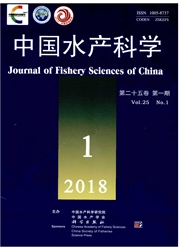

 中文摘要:
中文摘要:
为了研究双特异性磷酸酶(dual-specificity phosphatase 1,dusp1)基因与鱼类低温诱导的细胞凋亡之间的关系,本研究经Eco RI和Age1酶切构建plko.1-dusp1-sh RNA1,plko.1-dusp1-shRNA2,plko.1-negative control(nc),plko.1-EGFP的重组质粒,并分别与慢病毒包装质粒pCMV-DR8.9.1、pCMV-VSVG共同转染至293T细胞中,经293T细胞包装的病毒,感染斑马鱼(Danio rerio)胚胎成纤维样细胞(zebrafish embryos fibroblast like cell line,ZF4),RT-PCR检测表明dusp1成功被敲降。经嘌呤霉素筛选获得稳定表达细胞系,将细胞于28℃培养(正常对照组)或经10℃低温处理10 d,使用annexin V-FITC/Propidium lodide(PI)双色标记流式细胞术检测ZF4细胞凋亡情况。结果显示:低温胁迫下dusp1敲降的细胞凋亡(dusp1-shRNA1敲降,dusp1-kd1;dusp1-shRNA2敲降,dusp1-kd2)比例较nc组显著上调,其中早期凋亡和晚期凋亡细胞比例dusp1-kd1显著高于nc组,并且dusp1-kd1活细胞数显著低于nc组(P〈0.05),进一步证明dusp1参与鱼类冷应激过程,并在低温情况下保护细胞。该研究为后期对斑马鱼细胞低温胁迫实验奠定了基础,其中dusp1基因沉默型斑马鱼细胞在10℃低温处理10 d凋亡数显著大于对照组,证明dusp1在细胞凋亡信号通路中起到重要调控作用,为低温下研究斑马鱼基因的分子机制提供新的思路。
 英文摘要:
英文摘要:
The purpose of this study was to observe whether dual-specificity phosphatase 1 (duspl) is involved in the apoptosis of zebrafish (Danio rerio) cells under cold stress. The recombinant plasmids plko. 1-duspl-shRNA1, plko. 1-duspl-shRNA2, plko. 1- negative control, and plko. 1-EGFP were constructed using the restriction enzymes EcoRI and Agel. These plasmids were separately transduced into 293T cells together with the lentiviral packaging vectors pCMV-DRS.9.1 and pCMV-VSVG. The virus packaged by 293T cells was used to infect the ZF4 cell line derived from zebrafish, and analysis by real-time polymerase chain reaction showed that duspl was knocked down After puromycin selection for a stable duspl knockdown ZF4 cell line, the cells were cultured at 28 ℃ (normal temperature control) or 10℃ (cold stress) for 10 days. Afterwards, they were stained with propidium iodide and annexin V-fluorescein isothiocyanate, then analyzed by flow cytometry. The results showed that the rate of apop- tosis of the duspl- knockdown cells increased significantly more under low temperature than that of the wild-type control cells did, as compared with the normal temperature control group. Furthermore, we designed two small hairpin RNAs named kdl and kd2 based on the coding sequence of duspl. Under cold stress, the frequencies of late and early apoptotic cells in the kdl-treated group were significantly higher, and the frequency of living cells was significantly lower, than those of the negative control group (P〈0.05). The cells cultured at 28℃ showed no significant difference in the rate of apoptosis according to duspl silencing. However, under cold stress, apoptosis was significantly greater in the duspl-silenced group than in the control group, duspl is involved in several physiological processes of fish, and it negatively regulates MAPK family proteins; for example, it inhibits p38 phosphorylation. This paper provides a new insight into the regulation of the apoptotic response of fish cells under low-temperat
 同期刊论文项目
同期刊论文项目
 同项目期刊论文
同项目期刊论文
 期刊信息
期刊信息
